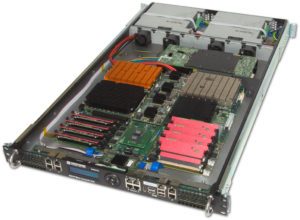Heterogeneous Hardware
Using on of our RECS® products, you can choose just the hardware that you need to get your job done best. The following architectures are supported:
- x86 CPU
- 32/64 Bit ARM CPU
- GPGPU, dedicated or integrated
- FPGA, standalone or as SoC
- PCIe SSD
We support all these architectures by using well-established industry standards like COM Express Type 6 + 7, COM-HPC, Nvidia Jetson NX, Nvidia Jetson TX2 and Toradex Apalis.
High Energy-Efficiency
Choosing the right technology for a problem can boost the overall energy efficiency dramatically. In some use cases, we measured an increased energy efficiency of factor 120 using an FPGA compared to a classical CPU. Still, comparing the FPGA against an optimized GPU implementation doubles the energy efficiency in some cases.
Energy costs are the biggest price boosters in data centres. That’s why a high energy efficiency is so important, you safe twice: First you pay less electricity costs for running the servers, then you pay less for cooling.
Let us help you to optimise your use case. Drop us a mail!
High-Speed Interconnect
The RECS|Box Durin, RECS|Box Deneb and t.RECS have a PCIe based high-speed, low-latency (HSLL) interconnect integrated. It supports Host-2-Host communication between Microservers and the possibility to share SR-IOV capable PCIe devices between multiple Microservers. It has a total bandwidth of 63 Gbit/s between Microserver.
Summary
Compared to traditional x86 CPU + GPU server solutions, christmann’s RECS®|Box microservers offer doubled density and nearly factor two better TCO.
IPTV suppliers spend a lot of effort and money to ship Set-Top-Boxes (STB) to their users. Replacing these STBs by centrally installed multimedia distribution nodes reduces the TCO substantially and enables the user to enjoy the multimedia experience on every streaming capable device.
Motivation
Today’s multimedia experience is changing. Until recently, suppliers of IP based video streaming had to ensure that users can easily use their service, thus Set-Top-Boxes (STB) are widely used. Unfortunately, using STBs brings disadvantages like additional hardware that has to be paid and kept running, the focus on classical TVs although the market is open for streaming on TVs, PCs and mobile devices.
Recently, the global availability of high-speed internet allows for cloud based multimedia streaming which wipes out the disadvantages of STBs. Additionally, it allows for many new features like thousands of TV/radio channels, video-on-demand, live interaction, time shift, multilingual audio channels and many more.
Technical concept
The technical concept to replace STBs by a cloud based video streaming service is easy and can efficiently be implemented via christmann’s ARM based RECS®|Box microservers.
As shown in the Figure, the input video can either be an existing (multicast) video stream or a video file. In either case, the video has to be decoded to get the raw image which can be done on the dedicated HW video decoding unit.
The decoded raw image can then be processed in different ways, e.g. to overlay it with other video streams (PiP), an OSD or other GUI elements. The multi-core CPUs and GPU can be used to process several video streams in parallel. Video editing might not be needed in any scenario, e.g. for video-on-demand with a centralised user input management, the raw image can be directly passed to the encoding unit.
The final image is the encoded in the hardware encoding unit and send to the user via IP protocol.
Videos
Here, you can find a short introduction video about our active RECS|Box 3.0 microserver architecture.
Testdrive
Are you interested in testing out a RECS®|Box and see what gain it can bring to your application? We are pleased to organise access to a test system for you.





